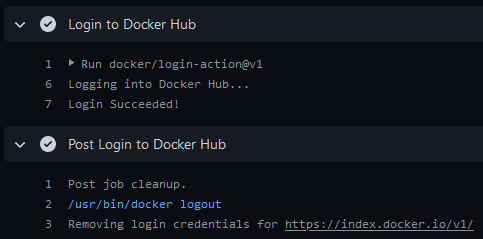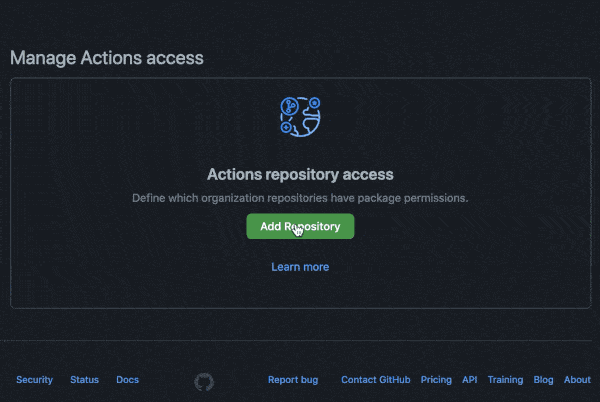[](https://github.com/docker/login-action/releases/latest)
[](https://github.com/marketplace/actions/docker-login)
[](https://github.com/docker/login-action/actions?workflow=ci)
[](https://github.com/docker/login-action/actions?workflow=test)
[](https://codecov.io/gh/docker/login-action)
## About
GitHub Action to login against a Docker registry.

___
* [Usage](#usage)
* [Docker Hub](#docker-hub)
* [GitHub Container Registry](#github-container-registry)
* [GitLab](#gitlab)
* [Azure Container Registry (ACR)](#azure-container-registry-acr)
* [Google Container Registry (GCR)](#google-container-registry-gcr)
* [Google Artifact Registry (GAR)](#google-artifact-registry-gar)
* [AWS Elastic Container Registry (ECR)](#aws-elastic-container-registry-ecr)
* [AWS Public Elastic Container Registry (ECR)](#aws-public-elastic-container-registry-ecr)
* [OCI Oracle Cloud Infrastructure Registry (OCIR)](#oci-oracle-cloud-infrastructure-registry-ocir)
* [Quay.io](#quayio)
* [Customizing](#customizing)
* [inputs](#inputs)
* [Keep up-to-date with GitHub Dependabot](#keep-up-to-date-with-github-dependabot)
## Usage
### Docker Hub
To authenticate against [Docker Hub](https://hub.docker.com) it's strongly recommended to create a
[personal access token](https://docs.docker.com/docker-hub/access-tokens/) as an alternative to your password.
```yaml
name: ci
on:
push:
branches: master
jobs:
login:
runs-on: ubuntu-latest
steps:
-
name: Login to Docker Hub
uses: docker/login-action@v1
with:
username: ${{ secrets.DOCKERHUB_USERNAME }}
password: ${{ secrets.DOCKERHUB_TOKEN }}
```
### GitHub Container Registry
To use the [GitHub Container Registry](https://docs.github.com/en/packages/getting-started-with-github-container-registry),
you need to [enable this feature for your personal or organization account](https://docs.github.com/en/packages/guides/enabling-improved-container-support).
To [authenticate against it](https://docs.github.com/en/packages/guides/migrating-to-github-container-registry-for-docker-images#authenticating-with-the-container-registry),
use the [`GITHUB_TOKEN`](https://docs.github.com/en/actions/reference/authentication-in-a-workflow) for the best
security and experience.
```yaml
name: ci
on:
push:
branches: master
jobs:
login:
runs-on: ubuntu-latest
steps:
-
name: Login to GitHub Container Registry
uses: docker/login-action@v1
with:
registry: ghcr.io
username: ${{ github.repository_owner }}
password: ${{ secrets.GITHUB_TOKEN }}
```
You may need to manage write and read access of GitHub Actions for repositories in the container settings:

You can also use a [personal access token (PAT)](https://docs.github.com/en/github/authenticating-to-github/creating-a-personal-access-token)
with the [appropriate scopes](https://docs.github.com/en/packages/getting-started-with-github-container-registry/migrating-to-github-container-registry-for-docker-images#authenticating-with-the-container-registry).
### GitLab
```yaml
name: ci
on:
push:
branches: master
jobs:
login:
runs-on: ubuntu-latest
steps:
-
name: Login to GitLab
uses: docker/login-action@v1
with:
registry: registry.gitlab.com
username: ${{ secrets.GITLAB_USERNAME }}
password: ${{ secrets.GITLAB_PASSWORD }}
```
### Azure Container Registry (ACR)
[Create a service principal](https://docs.microsoft.com/en-us/azure/container-registry/container-registry-auth-service-principal#create-a-service-principal)
with access to your container registry through the [Azure CLI](https://docs.microsoft.com/en-us/cli/azure/install-azure-cli)
and take note of the generated service principal's ID (also called _client ID_) and password (also called _client secret_).
```yaml
name: ci
on:
push:
branches: master
jobs:
login:
runs-on: ubuntu-latest
steps:
-
name: Login to ACR
uses: docker/login-action@v1
with:
registry: <registry-name>.azurecr.io
username: ${{ secrets.AZURE_CLIENT_ID }}
password: ${{ secrets.AZURE_CLIENT_SECRET }}
```
> Replace `<registry-name>` with the name of your registry.
### Google Container Registry (GCR)
> [Google Artifact Registry](#google-artifact-registry-gar) is the evolution of Google Container Registry. As a
> fully-managed service with support for both container images and non-container artifacts. If you currently use
> Google Container Registry, use the information [on this page](https://cloud.google.com/artifact-registry/docs/transition/transition-from-gcr)
> to learn about transitioning to Google Artifact Registry.
Use a service account with the ability to push to GCR and [configure access control](https://cloud.google.com/container-registry/docs/access-control).
Then create and download the JSON key for this service account and save content of `.json` file
[as a secret](https://docs.github.com/en/actions/configuring-and-managing-workflows/creating-and-storing-encrypted-secrets#creating-encrypted-secrets-for-a-repository)
called `GCR_JSON_KEY` in your GitHub repo. Ensure you set the username to `_json_key`.
```yaml
name: ci
on:
push:
branches: master
jobs:
login:
runs-on: ubuntu-latest
steps:
-
name: Login to GCR
uses: docker/login-action@v1
with:
registry: gcr.io
username: _json_key
password: ${{ secrets.GCR_JSON_KEY }}
```
### Google Artifact Registry (GAR)
Use a service account with the ability to push to GAR and [configure access control](https://cloud.google.com/artifact-registry/docs/access-control).
Then create and download the JSON key for this service account and save content of `.json` file
[as a secret](https://docs.github.com/en/actions/configuring-and-managing-workflows/creating-and-storing-encrypted-secrets#creating-encrypted-secrets-for-a-repository)
called `GAR_JSON_KEY` in your GitHub repo. Ensure you set the username to `_json_key`.
```yaml
name: ci
on:
push:
branches: master
jobs:
login:
runs-on: ubuntu-latest
steps:
-
name: Login to GAR
uses: docker/login-action@v1
with:
registry: <location>-docker.pkg.dev
username: _json_key
password: ${{ secrets.GAR_JSON_KEY }}
```
> Replace `<location>` with the regional or multi-regional [location](https://cloud.google.com/artifact-registry/docs/repo-organize#locations)
> of the repository where the image is stored.
### AWS Elastic Container Registry (ECR)
Use an IAM user with the ability to [push to ECR with `AmazonEC2ContainerRegistryPowerUser` managed policy for example](https://docs.aws.amazon.com/AmazonECR/latest/userguide/ecr_managed_policies.html#AmazonEC2ContainerRegistryPowerUser).
Then create and download access keys and save `AWS_ACCESS_KEY_ID` and `AWS_SECRET_ACCESS_KEY` [as secrets](https://docs.github.com/en/actions/configuring-and-managing-workflows/creating-and-storing-encrypted-secrets#creating-encrypted-secrets-for-a-repository)
in your GitHub repo.
```yaml
name: ci
on:
push:
branches: master
jobs:
login:
runs-on: ubuntu-latest
steps:
-
name: Login to ECR
uses: docker/login-action@v1
with:
registry: <aws-account-number>.dkr.ecr.<region>.amazonaws.com
username: ${{ secrets.AWS_ACCESS_KEY_ID }}
password: ${{ secrets.AWS_SECRET_ACCESS_KEY }}
```
If you need to log in to Amazon ECR registries associated with other accounts, you can use the `AWS_ACCOUNT_IDS`
environment variable:
```yaml
name: ci
on:
push:
branches: master
jobs:
login:
runs-on: ubuntu-latest
steps:
-
name: Login to ECR
uses: docker/login-action@v1
with:
registry: <aws-account-number>.dkr.ecr.<region>.amazonaws.com
username: ${{ secrets.AWS_ACCESS_KEY_ID }}
password: ${{ secrets.AWS_SECRET_ACCESS_KEY }}
env:
AWS_ACCOUNT_IDS: 012345678910,023456789012
```
> Only available with [AWS CLI version 1](https://docs.aws.amazon.com/cli/latest/reference/ecr/get-login.html)
You can also use the [Configure AWS Credentials](https://github.com/aws-actions/configure-aws-credentials) action in
combination with this action:
```yaml
name: ci
on:
push:
branches: master
jobs:
login:
runs-on: ubuntu-latest
steps:
-
name: Configure AWS Credentials
uses: aws-actions/configure-aws-credentials@v1
with:
aws-access-key-id: ${{ secrets.AWS_ACCESS_KEY_ID }}
aws-secret-access-key: ${{ secrets.AWS_SECRET_ACCESS_KEY }}
aws-region: <region>
-
name: Login to ECR
uses: docker/login-action@v1
with:
registry: <aws-account-number>.dkr.ecr.<region>.amazonaws.com
```
> Replace `<aws-account-number>` and `<region>` with their respective values.
### AWS Public Elastic Container Registry (ECR)
Use an IAM user with the ability to [push to ECR Public with `AmazonElasticContainerRegistryPublicPowerUser` managed policy for example](https://docs.aws.amazon.com/AmazonECR/latest/public/public-ecr-managed-policies.html#AmazonElasticContainerRegistryPublicPowerUser).
Then create and download access keys and save `AWS_ACCESS_KEY_ID` and `AWS_SECRET_ACCESS_KEY` [as secrets](https://docs.github.com/en/actions/configuring-and-managing-workflows/creating-and-storing-encrypted-secrets#creating-encrypted-secrets-for-a-repository)
in your GitHub repo.
```yaml
name: ci
on:
push:
branches: master
jobs:
login:
runs-on: ubuntu-latest
steps:
-
name: Login to Public ECR
uses: docker/login-action@v1
with:
registry: public.ecr.aws
username: ${{ secrets.AWS_ACCESS_KEY_ID }}
password: ${{ secrets.AWS_SECRET_ACCESS_KEY }}
env:
AWS_REGION: <region>
```
> Replace `<region>` with its respective value (default `us-east-1`).
### OCI Oracle Cloud Infrastructure Registry (OCIR)
To push into OCIR in specific tenancy the [username](https://www.oracle.com/webfolder/technetwork/tutorials/obe/oci/registry/index.html#LogintoOracleCloudInfrastructureRegistryfromtheDockerCLI)
must be placed in format `<tenancy>/<username>` (in case of federated tenancy use the format
`<tenancy-namespace>/oracleidentitycloudservice/<username>`).
For password [create an auth token](https://www.oracle.com/webfolder/technetwork/tutorials/obe/oci/registry/index.html#GetanAuthToken).
Save username and token [as a secrets](https://docs.github.com/en/actions/configuring-and-managing-workflows/creating-and-storing-encrypted-secrets#creating-encrypted-secrets-for-a-repository)
in your GitHub repo.
```yaml
name: ci
on:
push:
branches: master
jobs:
login:
runs-on: ubuntu-latest
steps:
-
name: Login to OCIR
uses: docker/login-action@v1
with:
registry: <region>.ocir.io
username: ${{ secrets.OCI_USERNAME }}
password: ${{ secrets.OCI_TOKEN }}
```
> Replace `<region>` with their respective values from [availability regions](https://docs.cloud.oracle.com/iaas/Content/Registry/Concepts/registryprerequisites.htm#Availab)
### Quay.io
Use a [Robot account](https://docs.quay.io/glossary/robot-accounts.html) with the ability to push to a public/private Quay.io repository.
```yaml
name: ci
on:
push:
branches: master
jobs:
login:
runs-on: ubuntu-latest
steps:
-
name: Login to Quay.io
uses: docker/login-action@v1
with:
registry: quay.io
username: ${{ secrets.QUAY_USERNAME }}
password: ${{ secrets.QUAY_ROBOT_TOKEN }}
```
## Customizing
### inputs
Following inputs can be used as `step.with` keys
| Name | Type | Default | Description |
|------------------|---------|-----------------------------|------------------------------------|
| `registry` | String | | Server address of Docker registry. If not set then will default to Docker Hub |
| `username` | String | | Username used to log against the Docker registry |
| `password` | String | | Password or personal access token used to log against the Docker registry |
| `logout` | Bool | `true` | Log out from the Docker registry at the end of a job |
## Keep up-to-date with GitHub Dependabot
Since [Dependabot](https://docs.github.com/en/github/administering-a-repository/keeping-your-actions-up-to-date-with-github-dependabot)
has [native GitHub Actions support](https://docs.github.com/en/github/administering-a-repository/configuration-options-for-dependency-updates#package-ecosystem),
to enable it on your GitHub repo all you need to do is add the `.github/dependabot.yml` file:
```yaml
version: 2
updates:
# Maintain dependencies for GitHub Actions
- package-ecosystem: "github-actions"
directory: "/"
schedule:
interval: "daily"
```